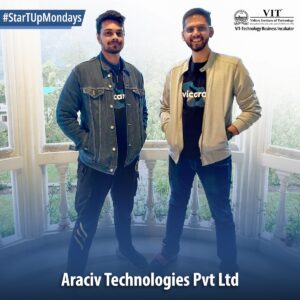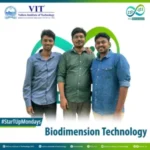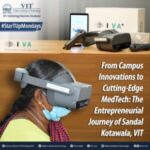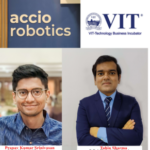N. Ramakrishnan
Using motion sensor technology for industrial purposes
Araciv shortly hopes to deploy its solution for the automobile industry
It was a hackathon in 2015 that got Adarsh Warrier and his friend and university batchmate Abhishek Satish on the path of entrepreneurship. While Warrier studied Electrical and Electronics Engineering, Satish was studying Electronics and Communications Engineering, at VIT in Vellore. They went to the Intel IIT Roadshow in 2015, did not win it, but ended up getting an internship at a Sequoia-funded IoT start-up, says Satish. The two worked in the start-up in Mumbai for a month or two, which is when they got acquainted with the start-up culture, he adds. When they returned to university, VIT TBI (Technology Business Incubator) was conducting an entrepreneurship camp, which concluded with a pitch competition. The pitch competition was the doorway to a larger competition where the prize money was ₹5 lakhs. It also included an introduction to investors. Satish recalls that they came second in the competition but were lucky to get through because one of the winners backed out. “We got to go on the national stage,” says Satish and adds that, by then they had also participated in a few international competitions.
Warrier and Satish registered their company, Araciv Technologies Pvt. Ltd., in the final semester of their fourth year in university. They received a grant from VIT TBI for student entrepreneurship, with VIT TBI also helping them get other grants offered by the Government of India through various schemes. “By the time we were in our first year of incorporation, which was 2017-18, we had received almost ₹20-25 lakhs in grant funding,” says Satish. After they graduated, they set up an office in VIT TBI, which helped them recruit interns from VIT. Warrier is the CEO and Satish the CTO.
At many critical steps, VIT TBI was extremely helpful, says Warrier. This started with their first business plan competition in which they came second and access to various grants. The most important contribution from VIT TBI was helping them understand the basic concepts of pitching, financials and business model planning when they were completely new to the start-up world, according to him. “We got introduced to our first investor through the TBI network. We also got introduced to mentors and advisers whenever needed and the TBI helped us hire our first interns from VIT,” adds Warrier.
The original idea in forming the company was to develop a wearable gesture controller. That is, you wear the device on the palm of your hand and you can control any digital interface through gestures, says Satish. “This could be your PC. You could change Windows with a quick swipe to your left or right. Or, you could take control of your mouse and move it. This could also be used in virtual reality for simulation of your hands. Our primary work was on gesture recognition technology for it to be real time,” says Satish. They worked on developing the product for a year after which they created an Indiegogo campaign. According to Satish, they recorded sales of $100,000-150,000 through that campaign.
But realisation dawned that it was capital intensive to be in consumer electronics; huge sums of money had to be spent on marketing. They talked to customers to understand what they were using the product for and got to know that many of them were using it for an abstracted model of sensory information, says Satish. This is when they started work on their first main product, which was the Vicara motion engine. They used all the firmware that abstracted the gesture recognition portion and started offering to different companies. They expanded the technology to include not only sensors but also videos and images to track motion across anything. They tried it with sports through two large clients, including a leading broadcaster which used motion tracking technology to have graphics along with a player’s image.
The next step for them was to get into industrial IoT (Internet of Things). They got a break when they signed up Maruti Suzuki, the country’s largest passenger car manufacturer, as a customer. Maruti Suzuki wanted them to use motion recognition technology to quantify a service technician’s productivity. It took them almost two years to build a hybrid system that would serve Maruti Suzuki’s purpose. Meanwhile, a few start-ups that were in the used vehicles business wanted them to come up with a solution that would help them track vehicles parked in yards. An employee had to spend quite a bit of time trying to locate the vehicle and these start-ups wanted to avoid that wastage of time. “As part of motion recognition technology,” says Satish, “we have built an indoor positioning system for them that is currently in pilot.” Vicara, which is the platform the company has built, will also shortly start a proof of concept with another leading automobile manufacturer for both the technician productivity solution and the indoor positioning system. The motion technology-based solution improves the efficiency of maintenance and repair operations. Data is collected for all the activities that are performed. Motion sensors are attached to commonly used tools in the service area to collect data on actions performed, including their accuracy, idle time and the time taken for execution.
According to Warrier, the company is working on solving for operational visibility for industry. “We are working towards launching our new product line that involves using generative AI to solve for the operational visibility problem in industry,” he adds. The challenges are many. Deep tech solutions require them to educate their clients understand the benefits of using their product. “Since we are working towards disrupting legacy industries, the project sizes are usually large, but sales cycles can be quite slow,” says Warrier and adds, “it is critical to walk a fine line between building custom implementation for one client and a generic product for many.”
According to Satish, they are in commercial talks with Maruti Suzuki to deploy their product and hope to get more clients quickly. The Bengaluru-based company has a 12-member team and as part of their expansion will also look to increase the team size. (EOM).










